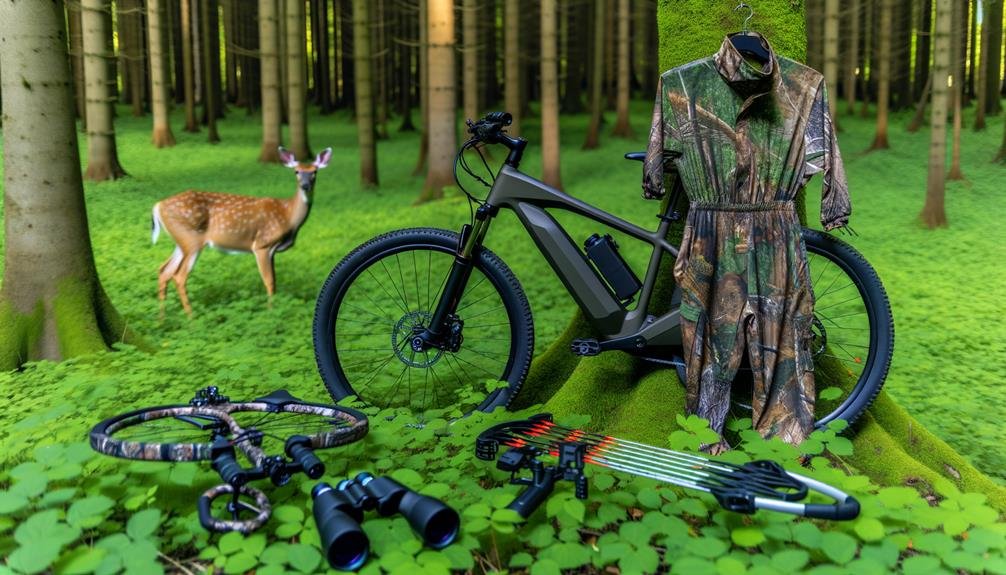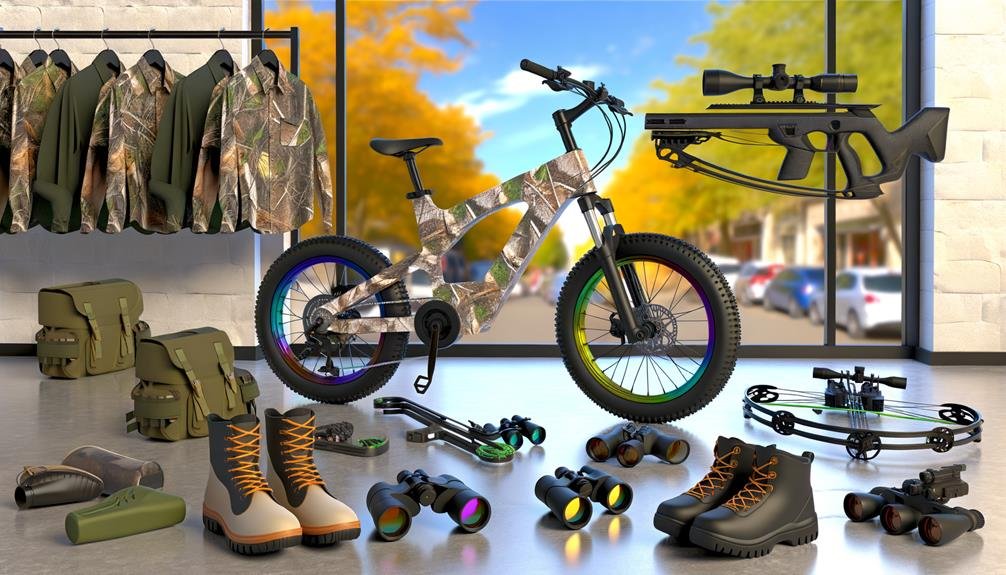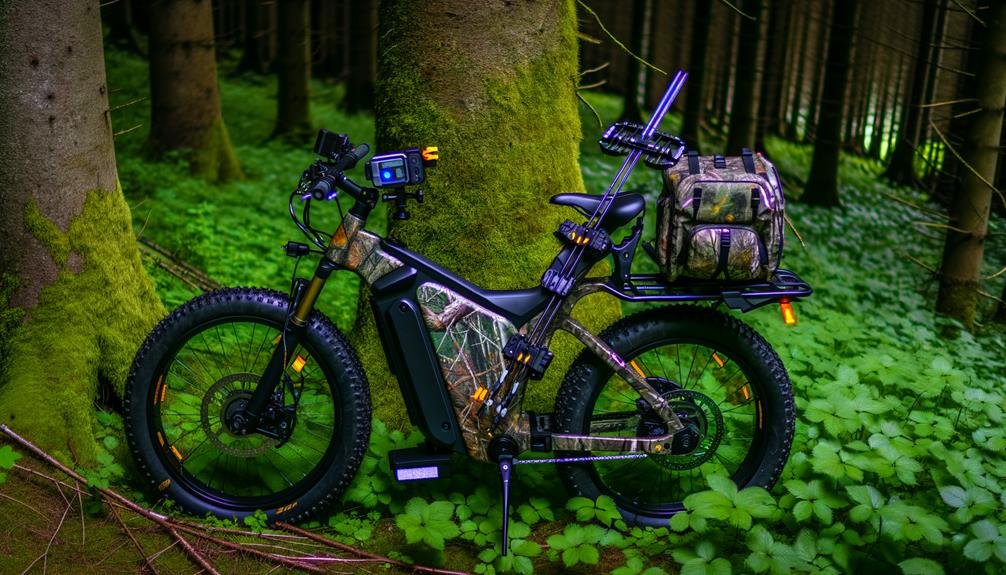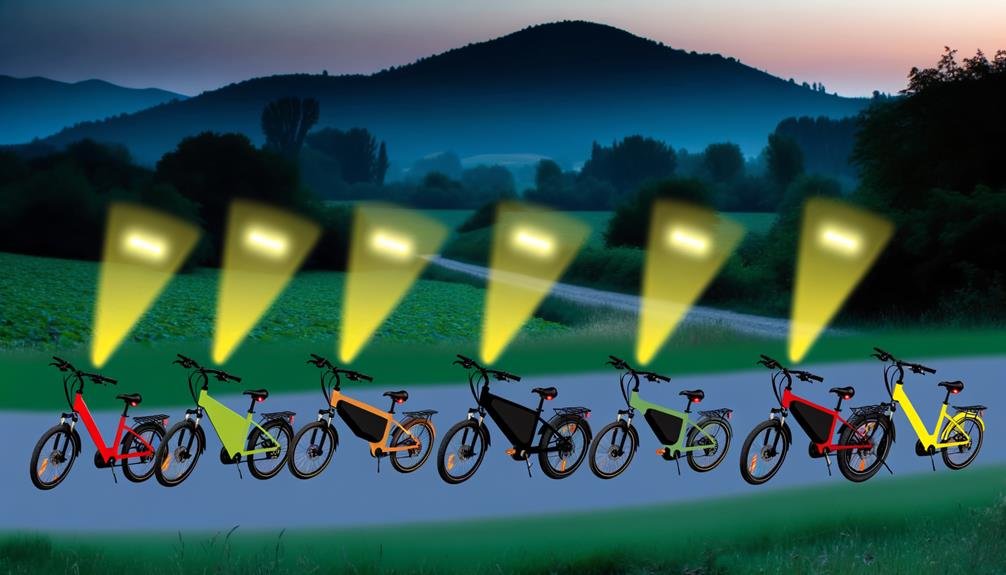Charles Miller is a veteran bike enthusiast with over 12 years of experience dealing with bikes as a mechanic. Despite immense love and expertise for...
We've noticed a growing trend among hunters – the use of electric bikes. These aren't your typical city commuter e-bikes, they're rugged, all-terrain vehicles designed to transport you and your gear across the most challenging of landscapes.
Yet, as this trend gains momentum, it's raising some significant questions. Can you legally use an electric bike for hunting? How effective are they? And most importantly, could they transform the way we hunt?
Let's investigate.
- Key Takeaways
- Understanding Electric Hunting Bikes
- Evaluating E-Bike Classifications
- Regulations for E-Bike Trails
- First-Timer Considerations
- Hunter Testimonials on E-Bikes
- Purchasing Your E-Bike
- Features of Top Electric Hunting Bikes
- Essential Hunting E-Bike Accessories
- Frequently Asked Questions
- Conclusion
Key Takeaways
- Electric hunting bikes are specifically designed for hunting, with features like pedal assist and throttle control.
- The classifications of e-bikes for hunting include Class 1, Class 2, and Class 3, each with different speed capabilities and legal restrictions.
- Regulations for e-bike usage on public lands vary by state and agency, so it's important to understand the rules before using an e-bike for hunting.
- Using an e-bike for hunting has benefits such as increased mobility, access to remote areas, and easier transportation of hunting gear, but considerations like local laws and finding the right fit should be taken into account when purchasing one.
Understanding Electric Hunting Bikes
Let's dive into the innovative world of electric hunting bikes, specifically designed with features like pedal assist and throttle control to help hunters navigate diverse terrains silently and efficiently. These motorized wonders aren't just bikes, they're game-changers in the hunting world. Imagine slipping through the woods, barely making a sound, zeroing in on your prey without alerting them to your presence – that's the advantage an e-bike offers.
These electric hunting bikes aren't only quiet, they're environmentally friendly too. They allow us to access remote hunting areas with ease while carrying our hunting gear efficiently. It's a win-win for us and the environment! But before hopping onto one, it's crucial to understand the factors affecting the performance of these e-bikes. From battery life to frame size and motor placement, even the suspension options – every detail counts.
However, we must remember that regulations and classifications of e-bikes for hunting vary by state and agency. From motor power to speed limits and even helmet requirements, it's important to know the rules before setting out on our hunt. Join us in embracing the future of hunting with electric hunting bikes!
Evaluating E-Bike Classifications
Let's get into the nitty-gritty of e-bike classifications for our hunting needs.
It's essential to understand the categories of e-bikes, the legal restrictions, and the performance differences between the classes.
Armed with this knowledge, we'll be better equipped to choose an e-bike that's not only legal to use, but also perfectly suited for our hunting adventures.
Understanding E-Bike Categories
Diving into the world of electric bikes, it's crucial to understand the different classifications, particularly if you're considering an e-bike for hunting. These categories distinguish e-bikes from traditional bicycles and clarify what to expect when riding an e-bike.
- Class 1 e-bikes engage the motor only when pedaling, reaching speeds up to 20 mph.
- Class 2 e-bikes are throttle-assisted. They don't require pedaling and can still reach 20 mph.
- Class 3 e-bikes, like Class 1, require pedaling but can reach 28 mph.
- E-bikes come in various forms, tailor-made for different terrains and uses.
E-Bike Legal Restrictions
While exploring the world of e-bikes, it's vital to consider the e-bike legal restrictions that vary based on their classifications. Notably, federal laws and the Bureau of Land Management have specific rules for eBike use on public lands, including national parks and national forests.
Here's a quick overview of e-bike classifications:
| Class | Description |
|---|---|
| Class 1 | Motor engages when pedaling, up to 20 mph |
| Class 2 | Throttle-assisted motor, up to 20 mph |
| Class 3 | Motor engages when pedaling, up to 28 mph |
Performance of Different Classes
After understanding the legal framework surrounding e-bikes, we can now turn our focus to the distinct performance characteristics of each class, which are crucial when selecting the perfect e-bike for hunting.
Let's delve into the heart of the matter:
- Class 1 e-bikes are pedal-assist only, reaching up to 20 mph – perfect for those stealthy approaches.
- Class 2 e-bikes, with throttle-assist, can also reach 20 mph without pedaling. Ideal for quick getaways!
- Class 3 e-bikes, also pedal-assist, can reach thrilling speeds up to 28 mph.
Regulations for E-Bike Trails
We're about to explore the legalities surrounding e-bike trail usage and how these laws intersect with hunting. It's a fascinating tapestry of state, city, and county regulations, with each jurisdiction having its own unique rules.
From federal laws to permissions from the Bureau of Land Management, we'll guide you through the maze and help you understand where you can legally take your e-bike for hunting.
Legal E-Bike Trail Usage
Navigating the legal landscape of e-bike trail usage can be a bit complex, as different agencies like the Department of the Interior (BLM) and the US Forest Service (USFS) each have their own set of rules for e-bikes on public lands. Understanding these rules is crucial, especially for those planning to use their electric bikes this hunting season.
E-bikes aren't allowed in wilderness areas.
Different categories of e-bikes exist with varying restrictions.
Some states treat e-bikes as non-motorized, while others see them as motorized vehicles.
Approval from the BLM Manager may be required for e-bike usage on non-motorized trails.
Legal e-bike trail usage is a matter of public safety, consumer product safety, and respect for our national parks and public lands. Let's ensure we're well-informed and considerate users.
Hunting and E-Bike Laws
Diving into the world of hunting with e-bikes, it's essential to understand that regulations can vary significantly between different agencies, states, and even private landowners.
Before embarking on your hunting trip, whether it's deer hunting or turkey hunting, check your local hunting and e-bike laws. For instance, in Oregon, e-bikes like our beloved QuietKat e-bikes, with their low-noise electric motor, are considered non-motorized and pedal-assist vehicles. However, some areas restrict use of eBikes entirely, like wilderness areas. Private landowners may also have unique policies.
So, can you use an electric bike for hunting? Absolutely! But, always ensure compliance with all regulations to enjoy a hassle-free, exhilarating experience.
E-bike hunting is a thrilling venture; let's embrace it responsibly!
First-Timer Considerations

As budding e-bike hunters, it's vital to get a solid grasp on the different classifications and regulations for electric hunting bikes in your area before you even think about making a purchase.
As first-timer considerations, we're eager to share some crucial points to ponder.
- Assess the range, battery life, and size of your prospective electric bike for hunting. Is it a mountain bike or a Fat Bike? Does it have the power to carry gear and sustain a hunt for big game?
- Understand the benefits and limitations. E-bikes, particularly those with Pedal Assist, can access remote areas with less noise, opening up new opportunities for riding e-bikes while hunting.
- Check out the additional hunting e-bike accessories available. Think cargo trailers for your gear or bike lights for early morning hunts.
- Familiarize yourself with the impact of e-bikes on wildlife and their popularity in roadless areas.
We're all in this together, and as a community of hunters embracing modern technology, we need to balance our love of the sport with a respect for nature and the rules that govern our activities.
Hunter Testimonials on E-Bikes
Countless hunters have experienced significant benefits from using e-bikes, leading to rave reviews and enthusiastic testimonials. The electric power of e-bikes allows hunters to ride their bike without pedaling, conserving energy for the hunt. This has revolutionized hunting, making it less strenuous and more enjoyable.
One of the most praised features of e-bikes is their fat tires. These offer stability and comfort when navigating over rough terrains, making hunting trips more successful. Choosing the right eBike instead of traditional hunting methods can make your hunt more efficient and enjoyable, according to hunter testimonials on e-bikes.
Many hunters speak highly of the ability to cover more ground and access remote areas effortlessly, a feat made possible only by e-bikes. This opens up new hunting opportunities and enhances the overall hunting experience.
Purchasing Your E-Bike

When you're ready to jump into the world of e-bike hunting, it's crucial to carefully consider the unique features and classes of various e-bikes, ensuring you choose one that perfectly suits your hunting needs. As off-road vehicles, mountain bikes equipped with an electric motor to propel the bicycle can be a great option. But how do you go about purchasing your e-bike?
We've got you covered:
- Start by looking at different classes and features of e-bikes. Does it have the range to cover your hunting ground? Is the motor powerful enough to handle steep terrain?
- Check out reputable brands that specialize in electric bikes for hunting. Brands like QuietKat, Rad Power Bikes, and Rambo Bikes have some top-notch options.
- Don't forget to check the local laws in your area regarding e-bikes. You don't want to get your new bike only to find you can't legally use it.
- Lastly, make sure to explore available accessories. Trailers, bags, lights – all these can enhance your hunting experience.
In the end, using an electric bike for hunting comes down to finding the right fit for you. Happy hunting!
Features of Top Electric Hunting Bikes
Diving into the world of electric hunting bikes, let's explore the key features that set the top models apart and make them an incredible asset for any hunting expedition.
The best electric bike for hunting is underpinned by a powerful yet small motor. This feature, combined with throttle control, ensures that you can navigate tough terrains and steep inclines with ease, and without exerting too much physical effort.
Features of top electric hunting bikes also include a fat tire design. These wide, sturdy tires are perfect for off-road terrains, providing unmatched traction and comfort. They're designed to weigh around 20-30 pounds, which strikes a balance between stability and maneuverability.
The motor assistance doesn't just put less strain on your body, it also makes much less noise, allowing you to glide silently through the wilderness. This is a game changer for hunters, ensuring you don't scare off your game.
Additionally, these bikes are equipped to help carry your hunting gear. From cargo trailers for transporting your game to waterproof pannier bags for your equipment, electric hunting bikes are designed to be your trusted partner on any hunting expedition.
Essential Hunting E-Bike Accessories

Let's gear up and delve into the indispensable accessories that can significantly enhance your hunting experience with an e-bike.
Using an electric bike for hunting on lands managed by the Forest Service, or in any OHV area or motorized trail system, offers a quiet alternative to traditional motor vehicles and dirt bikes.
- E-Bike Cargo Trailer: Leave no gear behind, or haul your game home with ease. This accessory is a game-changer, ensuring you never have to compromise on what you take on your hunting trips.
- QuietKat Waterproof Pannier Bag: Keep your essentials dry and within easy reach. This bag marries convenience and functionality perfectly.
- Rhino Grips XL: Hold your bow or rifle securely. You focus on the trail; let Rhino Grips handle your weapon.
- Explorer 900 Bike Light: Never be caught unawares in low light conditions. This light helps maintain visibility, ensuring you're safe and successful even when the sun goes down.
These essential hunting e-bike accessories offer a seamless blend of utility and convenience, redefining the hunting experience on motorized vehicles. They're not just accessories; they're your allies in the wild!
Frequently Asked Questions
Can an Electric Bike Pull a Deer?
Absolutely, we can use an e-bike for deer transportation. They're efficient, handle rough terrain, and offer a stealthy approach. However, we must consider battery life, gear capacity, optimal speeds, and safety measures.
Why Are Ebikes Not Allowed on Trails?
We've found that e-bikes are often barred from trails due to trail damage concerns, wildlife disturbances, and trail etiquette issues. Legal complications, traditional biking advocacy, accessibility debates, and safety considerations also play a role.
Who Makes the Best Electric Bike for Hunting?
We'd say QuietKat electric bikes are top-notch for hunting. They're efficient, stealthy, and great for rough terrains. They have long-lasting batteries, high weight capacity, durability, customization options, and low noise levels. Truly a hunter's dream!
How Fast Is the Electric Hunting Bike?
We're thrilled about electric hunting bikes! Their speed customization, terrain performance, and stealth advantages are impressive. With battery longevity, weight capacity, and safety features, they're perfect. Just remember to follow hunting regulations for safety.
Conclusion
So, can we use an electric bike for hunting? Absolutely! With their off-road capabilities, stealthy motors, and heavy-duty design, they're a game-changer for hunters.
But remember, it's crucial to check local regulations before hitting the trails. Once you've done that, gear up and get ready to explore those hard-to-reach hunting areas with ease and efficiency.
It's time to revolutionize your hunting experience with an electric hunting bike!

Charles Miller is a veteran bike enthusiast with over 12 years of experience dealing with bikes as a mechanic. Despite immense love and expertise for his Tacoma, he rides his Trek Ebike more. Anytime you meet him, you’ll either hear him talking about Bikes, or writing about all things bikes and cars on this blog.
More Posts


